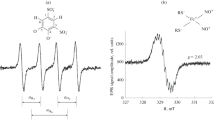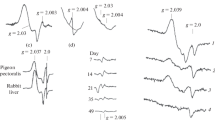Abstract
It has been established that, in the presence of S-nitrosothiols, cysteine, and mitochondria, dinitrosyl iron complexes (DNIC) coupled to low-molecular-weight ligands and proteins are formed. The concentration of DNIC depended on oxygen partial pressure. It was shown that, under the conditions of hypoxia, the kinetics of the formation of low-molecular DNIC was biphasic. After the replacement of anaerobic conditions of incubation with aerobic ones, the level of DNIC came down; in this case, protein dinitrosyl complexes became more stable. We proposed that iron-and sulfur-containing proteins and low-molecular-weight iron complexes are the sources of iron for DNIC formation in mitochondrial suspensions. It was shown that a combination of DNIC and S-nitrosothiols inhibited effectively the respiration of cardiomyocytes.
Similar content being viewed by others
References
E. Fassen and A. F. Vanin, in Radicals for Life the Various Forms of Nitric Oxide, Ed. by E. van Fassen, A. F. Vanin (Elsevier B.V., Amsterdam, 2006), pp. 19–74.
E. B. Men’shikova, V. Z. Lankin, N. K. Zenkov, et al., in Oxidative Stress, Prooxidants and Antioxidants (Slovo, 2006), pp. 84–108 [in Russian].
P. S. Brookes, A.-L. Levonen, S. Shiva, et al., Free Rad. Biol. Med. 33, 755 (2002).
V. Borutaite, R. Budriunaite, and G. C. Brown, Biochim. Biophys. Acta 1459, 405 (2000).
A. Galkin and S. Moncada, J. Biol. Chem. 282, 37448 (2007).
S. M. Nadtochiy, L. S. Burwell, and P. S. Brookes, J. Mol. Cell 42, 812 (2007).
N. A. Riobo, E. Clementi, M. Melani, et al., Biochem. J. 359, 139 (2001).
L. L. Pearce, A. J. Kanai, M. W. Epperly, and J. Peterson, Nitric Oxide 13, 254 (2005).
C. Giulivi, J. J. Poderoso, and A. Boveris, J. Biol. Chem. 273, 11038 (1998).
E. K. Ruuge, I. V. Zabbarova, O. V. Korkina, et al., Current Topics in Biophysics 29, 37 (2005).
K. P. Kashkarov, E. V. Vasil’eva, and E. K. Ruuge, Biokhimiya 59, 813 (1994).
P. S. Brookes, E. P. Salinas, K. Darley-Usmar, et al., J. Biol. Chem. 275, 20474 (2000).
V. Borutaite, R. Morkuniene, and G. C. Brown, FEBS Lett. 457, 155 (2000).
K. Seya, S. Motomura, and K. Furukawa, Clin. Sci. (Lond.) 112, 113 (2007).
L. L. Gudkov, K. B. Shumaev, E. I. Kalennikova, et al., Biofizika 52, 503 (2007).
L. V. Vakhnina and E. K. Ruuge, Biofizika 17, 690 (1972).
A. F. Vanin, V. A. Serezhenkov, V. D. Mikoyan, and M. V. Genkin, Nitric Oxide, Biol. Chem. 2, 224 (1998).
A. Tangeras, T. Flatmark, and D. Bakstrom, Biochim. Biophys. Acta 589, 162 (1980).
J. C. Toledo Jr., C. A. Bosworth, S. W. Hennon, et al., J. Biol. Chem. 283, 28926 (2008).
M. C. Kennedy, W. E. Antholine, and H. Beinert, J. Biol. Chem. 272, 20340 (1997).
N. V. Voevodskaya, V. A. Serezhenkov, C. E. Cooper, et al., Biochem. J. 368, 633 (2002).
P. A. Rogers and H. Ding, J. Biol. Chem. 276, 30980 (2001).
R. N. Watts, C. Hawkins, P. Ponka, and D. R. Richardson, Proc. Natl. Acad. Sci. USA 103, 7670 (2006).
K. B. Shumaev, A. A. Gubkin, S. A. Gubkina, et al., Biofizika 51, 472 (2006).
F. Dong, X. Zhang, B. Culver, et al., Clin. Sci. (Lond.) 109, 277 (2005).
Author information
Authors and Affiliations
Corresponding author
Additional information
Original Russian Text © K.B. Shumaev, I.V. Sviryaeva, S.A. Gubkina, T.S. Krivova, A.F. Topunov, A.F. Vanin, E.K. Ruuge, 2010, published in Biofizika, 2010, Vol. 55, No. 3, pp. 460–466.
Rights and permissions
About this article
Cite this article
Shumaev, K.B., Sviryaeva, I.V., Gubkina, S.A. et al. Formation of dinitrosyl iron complexes in cardiac mitochondria. BIOPHYSICS 55, 406–411 (2010). https://doi.org/10.1134/S0006350910030097
Received:
Accepted:
Published:
Issue Date:
DOI: https://doi.org/10.1134/S0006350910030097




